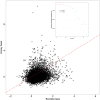Queens and Workers Contribute Differently to Adaptive Evolution in Bumble Bees and Honey Bees
- PMID: 28957466
- PMCID: PMC5622336
- DOI: 10.1093/gbe/evx182
Queens and Workers Contribute Differently to Adaptive Evolution in Bumble Bees and Honey Bees
Abstract
Eusociality represents a major transition in evolution and is typified by cooperative brood care and reproductive division of labor between generations. In bees, this division of labor allows queens and workers to phenotypically specialize. Worker traits associated with helping are thought to be crucial to the fitness of a eusocial lineage, and recent studies of honey bees (genus Apis) have found that adaptively evolving genes often have worker-biased expression patterns. It is unclear however if worker-biased genes are disproportionately acted on by strong positive selection in all eusocial insects. We undertook a comparative population genomics study of bumble bees (Bombus) and honey bees to quantify natural selection on queen- and worker-biased genes across two levels of social complexity. Despite sharing a common eusocial ancestor, genes, and gene groups with the highest levels of positive selection were often unique within each genus, indicating that life history and the environment, but not sociality per se, drives patterns of adaptive molecular evolution. We uncovered differences in the contribution of queen- and worker-biased genes to adaptive evolution in bumble bees versus honey bees. Unlike honey bees, where worker-biased genes are enriched for signs of adaptive evolution, genes experiencing positive selection in bumble bees were predominately expressed by reproductive foundresses during the initial solitary-founding stage of colonies. Our study suggests that solitary founding is a major selective pressure and that the loss of queen totipotency may cause a change in the architecture of selective pressures upon the social insect genome.
Keywords: fitness; kin selection; natural selection; sociality.
© The Author 2017. Published by Oxford University Press on behalf of the Society for Molecular Biology and Evolution.
Figures



Similar articles
-
Population genomics of the honey bee reveals strong signatures of positive selection on worker traits.Proc Natl Acad Sci U S A. 2014 Feb 18;111(7):2614-9. doi: 10.1073/pnas.1315506111. Epub 2014 Jan 31. Proc Natl Acad Sci U S A. 2014. PMID: 24488971 Free PMC article.
-
Social control of egg-laying in independently nest-founding bumble bee queens.BMC Ecol Evol. 2025 Apr 9;25(1):30. doi: 10.1186/s12862-025-02364-0. BMC Ecol Evol. 2025. PMID: 40205330 Free PMC article.
-
The transcription factor Krüppel homolog 1 is linked to hormone mediated social organization in bees.BMC Evol Biol. 2010 Apr 30;10:120. doi: 10.1186/1471-2148-10-120. BMC Evol Biol. 2010. PMID: 20429952 Free PMC article.
-
Integration of information from multiple sources drives and maintains the division of labor in bumble bee colonies.Curr Opin Insect Sci. 2023 Dec;60:101115. doi: 10.1016/j.cois.2023.101115. Epub 2023 Sep 12. Curr Opin Insect Sci. 2023. PMID: 37704097 Review.
-
Molecular tools and bumble bees: revealing hidden details of ecology and evolution in a model system.Mol Ecol. 2015 Jun;24(12):2916-36. doi: 10.1111/mec.13198. Epub 2015 May 19. Mol Ecol. 2015. PMID: 25865395 Review.
Cited by
-
Thrice out of Asia and the adaptive radiation of the western honey bee.Sci Adv. 2021 Dec 3;7(49):eabj2151. doi: 10.1126/sciadv.abj2151. Epub 2021 Dec 3. Sci Adv. 2021. PMID: 34860547 Free PMC article.
-
Non-Destructive Genotyping of Honeybee Queens to Support Selection and Breeding.Insects. 2020 Dec 21;11(12):896. doi: 10.3390/insects11120896. Insects. 2020. PMID: 33371316 Free PMC article.
-
Gene expression and epigenetics reveal species-specific mechanisms acting upon common molecular pathways in the evolution of task division in bees.Sci Rep. 2021 Feb 11;11(1):3654. doi: 10.1038/s41598-020-75432-8. Sci Rep. 2021. PMID: 33574391 Free PMC article.
-
Conserved Genes Underlie Phenotypic Plasticity in an Incipiently Social Bee.Genome Biol Evol. 2018 Oct 1;10(10):2749-2758. doi: 10.1093/gbe/evy212. Genome Biol Evol. 2018. PMID: 30247544 Free PMC article.
-
Leaf-damaging behavior by queens is widespread among bumblebee species.Commun Biol. 2025 Mar 14;8(1):435. doi: 10.1038/s42003-025-07670-3. Commun Biol. 2025. PMID: 40082690 Free PMC article.
References
-
- Alford D. 1969. A study of the hibernation of bumblebees (Hymenoptera: Bombidae) in southern England. J Anim Ecol. 38(1):149–170.
-
- Amsalem E, Galbraith DA, Cnaani J, Teal PE, Grozinger CM.. 2015. Conservation and modification of genetic and physiological toolkits underpinning diapause in bumble bee queens. Molec Ecol. 24(22):5596–5615. - PubMed
-
- Arias MC, Sheppard WS.. 1996. Molecular phylogenetics of honey bee subspecies (Apis mellifera L.) inferred from mitochondrial DNA sequence. Molec Phylogenet Evol. 5(3):557–566. - PubMed
-
- Bourke AFG. 2011. Principles of social evolution. Oxford; New York: Oxford University Press.
Publication types
MeSH terms
LinkOut - more resources
Full Text Sources
Other Literature Sources

